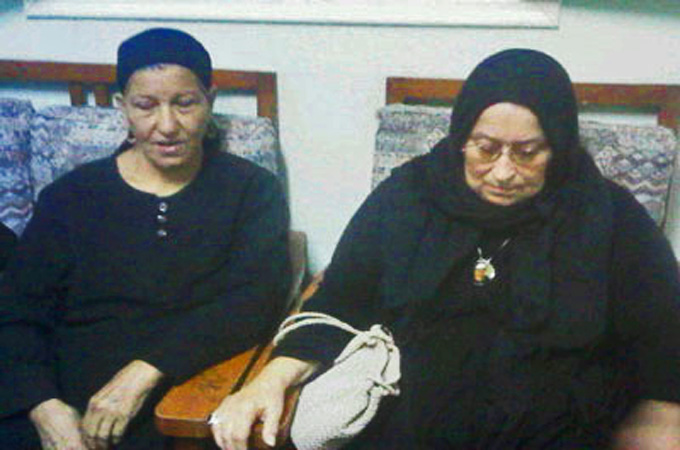Khaled is Mina, Mina is Khaled
Powerful political forces in Egypt have used the ‘sectarian card’ to divide the people and shift the blame.

 |
| The mothers of Khaled and Mina mourn their sons who reportedly died at the hands of Mubarak’s police [Al Jazeera] |
As the cliché goes, a picture is worth a thousand words. And the image of the mothers of Khaled Said and Mina Daniel at Mina’s funeral is as powerful as they come.
Khaled Said had reportedly died from the police brutality of the Mubarak regime, the graphic images of his corpse had arguably helped galvanise the 2011 Egyptian revolution. Mina Daniel, allegedly killed in the Maspero massacre carried out by military police, was part of the January 25 youth movement. The image of the two mothers, each having lost a son, united, sad; is an image that personifies Egypt’s ongoing woes.
As the massacre of Maspero unfolded, the worldwide media response had begun.”The Christians of Egypt are under attack” ran global headlines, framing the events solely within a sectarian context. Some commentators had gone as far as labelling the events an “anti-Christian pogrom“.
As the dust settles, and objective analysis takes hold, the Maspero massacre can be contextualised within the wider uprising of the Egyptian people that had begun on January 25, 2011.
In his critically acclaimed book, Distraction: A Guide to Freedom, Australian philosopher Damon Young argues “distractions, from sports trivia to trashy supermarket magazines and immersive computer games – are often our way to elude the existential burden.”
This tragic episode in Egyptian sectarian relations frighteningly embodies Young’s assertion because it reveals the fallacies propagated through a corrupt state media that painted its citizens, be it Copts or not, as agitators. In essence, they detracted and distracted the wider populace from the lethality of Egypt’s ruling Supreme Council of the Armed Forces (SCAF) on the ground by portraying them as hapless soldiers without adequate weaponry against a mob of Copts.
In fact, Egyptian state media managed to incite sectarian hysteria by turning perpetrators into victims and vice versa.
Apart from alleging that Coptic protesters had weapons and attacked army personnel directly, the state propaganda went as far as saying that the United States was going to intervene directly to protect the Coptic minority. The foreign plot scenario is constantly invoked in a cowardly media machine in order to whip up so-called “patriotic passions” with religious undertones in an already tense situation, where army officers, Salafis, hired regime thugs and armoured personnel carriers (APC) provide for a combustible mix.
‘Mowing down protesters’
While the final details of what transpired in Maspero are yet to clearly emerge, its clear to all that it was a massacre – 27 dead and more than 300 wounded.
The army has claimed it had lost some soldiers but says it has buried them in private without fanfare not to “disturb the country’s unity”. The Copts however, chose to have a very public funeral – broadcast on local and international television stations. The dead were buried in the same cemetery as the dead from the church attack in January 2011, sending a clear message that the Copts continue to bleed, both in the pre- and post-Mubark eras.
|
Inside Story: Egypt’s clash of religions |
Footage of APCs mowing down protesters in front of Maspero is a haunting deja-vu of Mubarak’s State Security mowing down protesters on January 28 – the “Day of Anger” – and the symbolism is not lost on anyone. Mina himself took part on January 28, as the Egyptian youth faced down the brutality of the Mubarak regime. He survived, only to perish months later at the hand of the military.
The military’s heavy-handed response to a demonstration by the Copts has echoes of Mubarak’s days. Indeed, what happened can be explained as SCAF attempting to crush any dissent against its rule.
An early analysis of the post-incident environment concludes that the response had backfired on SCAF, and arguably had the opposite effect of further uniting Egyptians against military rule. In a clear indication that “divide and conquer” tactics long championed by the Mubarak regime had begun to wear off, Egyptian parties and political groups from across the spectrum had joined in condemnation of SCAF’s heavy handed and brutal response.
Funeral processions and rallies with Muslims and Copts marching together have been held across Egypt, including a rally the following Friday in Tahrir, demanding retribution for the “martyrs”.
Young explains how language colours reality and puts forward the idea that states engage in “war morality” where they disseminate and bombard their subjects with “weapons of mass distraction” in order to divert their attention from the fundamental freedoms at stake.
Simply put, this is not the first, or unfortunately the last, time the sectarian card has been used to the Egyptian government’s advantage. Yet, it is becoming apparent the current regime cannot sustain the zero-sum game of dividing and conquering – because it can only last so long in an increasingly politically aware and socio-economically frustrated population.
Mubarak had played the sectarian card skillfully in order to keep himself in power for decades and it seems like SCAF is following in his footsteps. He forgot that the Egyptian people have the ace up their sleeve. Egypt’s military rulers should recognise that the powerful and unifying spirit of the revolution cannot be dismantled.
Those dressed in mournful black remind us that this is in an all-Egyptian revolution.
Adel Abdel Ghafar is a research student at Sydney University. Follow him on Twitter: @dooolism.
Farid Y. Farid is a doctoral candidate and freelance writer based at the University of Western Sydney. Follow him on Twitter: @FaridYFarid